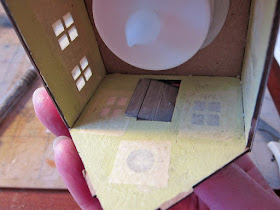This little house stands only about 3" tall, not counting the base. It"s available here from Alpha Stamps, and if you read on through to the bottom, I'll talk about how it was put together. Meanwhile, here are some more photos. The tiny family who lives here sure did a good job of decorating the tallest tree! It's easy to attach those beads; I just dipped them in some tacky glue and stuck them into the branches.
I left the front door ajar because it seemed a bit more welcoming. That door is tiny: less than one inch tall, and the doorknob is actually the head of a straight pin. I just pushed the pin through and clipped off the excess. The wreath was punched out with a regular hole punch. I drew around the circumference with some dimensional paint, and then added red holly berries with the head of a pin. Here's a little "in progress" photo. The wreath is sitting on a removable glue dot, on top of an old drink stirrer. That's about the only way I could keep it steady while I painted it!
You can totally fence your house in, or you can use an xacto knife to cut a little gate. I think it looks nice to have an open gate with the pathway leading to the front door.
Here's something fun: there is a tea light inside the house. At night, the house looks warm and cozy with all the lights on.
Here's how to assemble the house. It arrives flat, so you first need to punch out all the pieces. An xacto knife will help separate the tiny parts that are attached. Below you see Window Trims on the left, the roof and part of the base in the top center, the house itself bottom center, and a Chimney & Dormers set on the right. I used the dormer windows, but not the chimney for this house.
Once your pieces are removed, it's good to lay them out to make sure you have them all together and you know what goes where. That tea light will go into the house before everything is glued up.
I used a circle template to draw a hole in the bottom of the house for the tea light. The hole is just a little smaller than the tealight, so the light can still sit on the floor, but I have access to the on/off switch and the battery.
Now back to the tutorial:
If you choose to cover the walls with paper instead of painting the outside, here's how to cover the walls without covering your windows: place the wall (inside up on the reverse side of the paper) on the corner of the paper you're using. Take a straight pin and punch a hole on each of the four corners of every window. This will show you where to cut out. Make sure you paint the window mullions on the outside wall before you glue your paper down! I painted mine white, to match the trim.
Once you've poked holes on the edges of all your windows, use a straight edge and an xacto to cut out the window holes. Here I've cut three of the sides, then I'll go back and cut out the tops and bottoms.
Put a little bit of glue on the edges of the walls, and assemble. I used Tacky Glue on mine, and I only had to hold things in place a short time before everything was adhered.
One thing I didn't get photos of was the dormer windows. Before I put their little roofs on I held them in place on the roof of the house and used a pencil to draw a square inside the perimeter of the dormer. I then cut that square out of the roof so the light also shines through the dormers. I like it that the entire house is lit up when the tea light is on.
Here's the base of the house, all assembled and painted white. At this point, I have added Tiny Scalloped Shingles to the front of the roof, and applied Snow Tex to the roof and windows of the house. I have also began placing the trees and deer, who although cute, did not make the final cut. I drew around the house and trees with a pencil. If your house lights up, you will need a hole in the base to access that tea light. Cut out that hole before you glue anything down!
Here's the base all snowed in with Snow-Tex. Notice the hole for the tea light access to the house. Once the snow is dry, you can glue down your elements. You may want to go back in and add a little more snow around the house and trees once they're placed.
Once everything's glued down, you've got a Holly Jolly Christmas house that's cute both day and night.
For a complete list of supplies, click here!




































